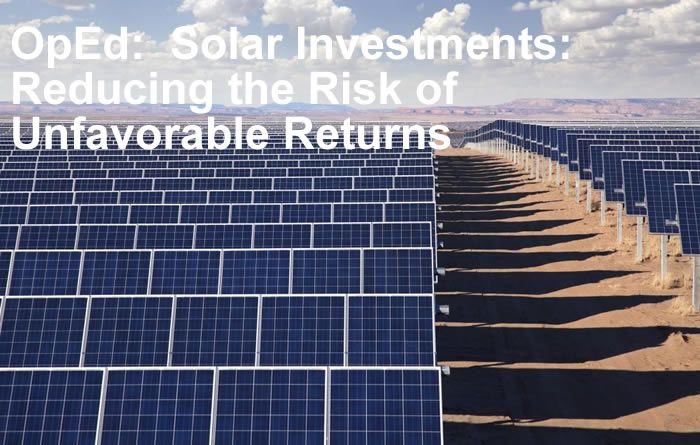As the PV industry enters the next stage of its evolution, there is good reason to believe all the risks of a solar array will be assessed in greater detail. More scrutiny may uncover potentially underperforming components and high O&M costs before an investment is made.
Brad Forth | Array Technologies
Competitive prices, on-time delivery, quick installation – it’s all too easy to make assumptions about what utility-scale solar investors may want. However, what’s commonly overlooked or discounted by many outside the investment community, is what’s most important and highly sought after from those within it: a low-risk investment with steady and predictable cash flows for 20-30 years.
Over the last decade the utility-scale market of the solar PV industry has greatly improved its competitiveness as an energy generation source. It has been exciting to watch the cost of electricity produced from PV power plants become competitive with a range of traditional energy sources.
Investing in Utility-Scale Solar
For an investor to take interest in a solar project, risk must be reduced to an absolute minimum. A solar array must generate electricity at a predictable operational cost structure in order to deliver long-term, reliable returns.
The PV industry has made great strides in delivering certainty for the investment community. The ever-increasing number of institutional investors that are now backing PV projects is a fruit of these labors, but there is still a way to go.
Testing and Due Diligence
Many project developers turn to independent engineers and quality assurance providers to carry out the required due diligence when it comes to key PV power plant components. This is particularly true in regards to solar modules. Testing laboratories and regimes are quite sophisticated, with the ability to expose modules to extreme operating conditions and simulate their likely performance over their operating life.
Module failures are well documented and, in some cases, such as potential induced degradation (PID), documented in great detail. Unfortunately, this isn’t the case with the range of components often lumped together under the tag “Balance of Systems.” This includes components such as electrical cabling, connectors, and tracking systems, and it is a crucial oversight.
Taking a Closer Look at Trackers
Tracker deployment is growing rapidly. GTM Research forecasts implentation as high as 80 to 90 percent in key PV markets including the U.S., Latin America, Middle East, and Australia as soon as this year.
This makes it all the more worrying that the risks posed by component failure in tracker systems are not well understood, analyzed or priced. What’s more concerning, there is a lack of understanding of the impact tracker failures or faulty operation can have on a project’s bottom line and Net Present Value (NPV). Given this, independent analyst, TÜV Rheinland recently conducted the first-of-its kind investigation on tracker reliability. The resulting “Risk and Economic Analysis on Two Tracker Architectures” report looked at the most popular tracker architectures, centralized and decentralized, investigating each according to its individual component and system reliability.
Assessing Risk and Economic Impact
The report found that the centralized architecture had vastly lower scheduled and unscheduled Operations and Maintenance (O&M) costs when compared to the decentralized architecture studied.
According to the study, the lower O&M costs of the centralized architecture translated into $6.4 million over 30 years for a 100-megawatt facility. Other findings showed the centralized tracking architecture loses 39 percent less energy due to component failures compared to the alternative architecture; has a 6.7 percent lower levelized cost of energy (LCOE); and nearly 4.6 percent higher net present value (NPV).
The Bottom Line
Breaking down the O&M costs in more detail, the report found unscheduled O&M costs to be the most damaging to a PV project’s bottom line. This should give cause for investors to take a close look at all components when investing in utility-scale solar. Notwithstanading the fundamental differences between tracker architectures, many solar plant financial models incorrectly assume identical O&M expenses. Financial returns on solar PV power plants can be significantly impacted by erroneous O&M modeling assumptions.
As the PV industry enters the next stage of its evolution, there is good reason to believe all the risks of a solar array will be assessed in greater detail. More scrutiny may uncover potentially underperforming components and high O&M costs before an investment is made. For investors, this can’t happen quick enough, after all, it’s what they really want: predictable cash flows with minimum risk.
The content & opinions in this article are the author’s and do not necessarily represent the views of AltEnergyMag
Comments (0)
This post does not have any comments. Be the first to leave a comment below.
Featured Product

HPS EnduraCoilTM Cast Resin Medium Voltage Transformer
HPS EnduraCoil is a high-performance cast resin transformer designed for many demanding and diverse applications while minimizing both installation and maintenance costs. Coils are formed with mineral-filled epoxy, reinforced with fiberglass and cast to provide complete void-free resin impregnation throughout the entire insulation system. HPS EnduraCoil complies with the new NRCan 2019 and DOE 2016 efficiency regulations and is approved by both UL and CSA standards. It is also seismic qualified per IBC 2012/ASCE 7-10/CBC 2013. Cast resin transformers are self-extinguishing in the unlikely event of fire, environmentally friendly and offer greater resistance to short circuits. HPS also offers wide range of accessories for transformer protection and monitoring requirements.

